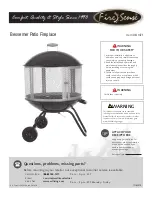
OWNER’S MANUAL Model # 8890 DVI-Ht
Page 22 of 32
PILOT AND BURNER FLAMES
Variable Output Control
The gas control valve is equipped with a variable
output control. This control varies the rate of heat
produced by the unit by varying the gas pressure to
the main burner tube. The length of the burn cycle is
affected by a combination of heat output and the
thermostat setting. If your stove turns on and off too
often, try, first, reducing the burn cycle by turning the
HI/LOW knob, on the control valve to a lower setting.
Using the variable output control, the heat output of
the unit can be reduced for mild fall and spring
months, or maximized for the colder winter months.
This adjustment is made, by the homeowner, as
necessary by turning the variable output control knob
to “HI”, “LO”, or any setting in between.
Ht (High Turndown)
The DVI is equipped with a dual valve system. This
allows for the dramatic turndown that most other gas
systems do not feature. Turn the secondary valve off,
and the rear flames go out leaving the front flames on
for a more relaxed ambience simmer. Turn the rear
flames back on to enjoy the high flames for more
heat. This
Ht
system is technologically designed to
cover all aspects of heating pleasure.
Air Shutter
The air shutter is adjustable while the stove is
burning. The two air shutters on the ember burner
are adjustable. The right one (while facing the front
of the stove) is for the low burn portion of the ember
burner and the left one (while facing the front of the
stove) is for the high burn portion of the ember
burner. The adjusters are located underneath the
front of the unit, and operated by using a 3/8” wrench
to loosen the bolt. Sliding the control levers forward or
backward will open or close the shutters. This nut is
gets hot and should not be touched. Use only metal
tools for this adjustment. Tighten the nut after making
adjustment. The air shutter is factory set and only a
qualified gas technician should make adjustments.
Pilot Adjustment
The pilot light is preset by the manufacturer and
should not need adjustment. Ensure the pilot flame is
large enough to engulf the thermopile and the
thermocouple, but not so large as to create excessive
noise or consume excessive gas. However,
adjustment is possible by means of the pilot light
adjustment screw located on the gas control valve.
Open the valve door to access the pilot adjustment
screw.
Refer to # 3 of Figure 8, on page 15
, to
determine the location of the pilot adjustment screw.
Note that the pilot flame must engulf the thermopile
so the thermopile can generate sufficient voltage (325
to 750mv) to power the millivolt gas control valve.
The flame on the pilot should look like
Figure 13
.
Controlling the DVI -Ht by the wall-mounted
thermostat may become erratic, nonexistent, or the
unit may go out, if the pilot flame is too small or
misdirected away from the thermopile.
Figure 13: Top Convertible Pilot
Burner Flame Appearance
Once the unit is lit, observe the flame pattern and
adjust as necessary. Perform a periodic visual check
of the burner flame. To determine if the burner flame
needs adjustment, view the flame pattern with the
variable output control knob at its highest setting
(turned fully counter-clockwise). Allow the unit to
operate for 10 minutes enabling the entire unit to
reach temperature and for the flame pattern to
stabilize. The flame pattern should be similar to the
one shown in
Figure 14
. There are several guidelines
to aid in determining if the flame pattern is correct:
1) The flame should not be dirty, smoky, sooty, or
lick the top of the stove.
2) The flame should not rise off of the burner tube,
called “lifting”. Flames should not impinge
heavily on log set; they should “fit” through the
pre-formed spaces designed in the log set.
Figure 14: Flame Pattern











































